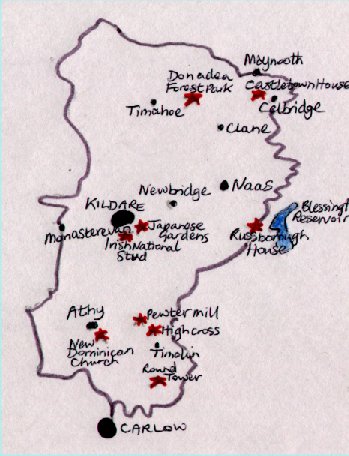|
| Kildare lies at the heart of horse country. The Curragh Racecourse
lies nearby and there are countless stud farms. Horse sales take place
in Kill.
Castletown House Castletown House is situated at Celbridge in County Klildare. This Palladian mansion was built for the Speaker of the Irish Parliament, William Conolly in 1722-1732. Alessandro Galilei, a Florentine architect designed it. Lady Louisa Lennox, wife of William Conolly's great-nephew was responsible for the late 18th century interiors. She began living in the house in 1758. The rooms are truly magnificent. There is plasterwork by the Francini brothers decorating the stairs. There is the print room, the last remaining one in Ireland, with its Italian engravings which are pasted directly to the walls as was the fashion. There are long panels in the Boudoir which were inspired by Raphael works in the Vatican, and the dining room was designed by William chambers who also was responsible for designing the Marino Casino (just north of Dublin), it shows his strong Neo-Classical ideas. The Conolly family owned the house until 1965 when it was taken over by the Irish Georgian Society. It now belongs to the State and is open to the public. In the grounds is a folly erected to the memory of William Conolly by his wife Katherine in the year 1740. It was designed by the architect of Russborough house (in County Wicklow), Richard Castle. Japanese Gardens The Japanese Gardens share the same estate as the National Stud, see below. Lord Wavertree who created the stud also had a love of all things oriental, as was the style in Edwardian times. A Japanese gardener laid out the gardens in 1906-1910, with his son and some 40 assistants. The garden is a delight to visit for children and adults alike, with maples, bonsi, magnolias, elaborate rockeries, streams and pools,miniature bridges, stone lanterns, and various follies. Kildare A religious community was founded on the site where Kildare now is by St. Brigid in 490. The town is now dominated by a Cathedral in her name. This Cathedral was very unusual in many ways, one of which was that both nuns and monks lived there under the same roof. They also practiced certain pagan rites, such as the burning of a perpetual fire which continued until the 16th century. The round tower was built in the 12th century and it has a romanesque doorway. The Cathedral was rebuilt in Victorian times but they stuck to the original design. Monasterevin This market town is situated where the Grand Canal crosses the River Barrow. It is a Georgian town, and saw wealth in the 18th century when the canals were used for trading by barge. There is a fine aqueduct to see. Moore Abbey This abbey was built in the 18th century, and is situated next to the church in Monasterevin. Although the 18th century is when it was built there had been a monastic settlement on the site before. The Victorians remodelled this Gothic mansion, which was once the home of the Earls of Drogheda. In the 1920's Moore Abbey became the home of the famous Irish Tenor, john McCormack. It is now a hospital. Peatland world Situated at Lullymore, 9km (6 miles) north east of Rathangan, this exhibition about the history of bogs is based in an old farm. It is based in the centre of the Bog of Allen which is a raised bog that lies across the counties of Kildare, Laois and Offaly. The exhibition covers all aspects of bogland, from how they were formed, the flora and fauna, and also archaeological finds. Robertstown Robertstown is a 19th century canalside village. It is built on the Grand Canal which carries on to enter Dublin. Barges carrying goods went up and down the canals till the 1960's, but now they have been replaced by pleasure cruisers. The Grand Canal company's Hotel which was built for passengers in 1801 is now used for banquets. The National Stud Situated south of Kildare town this national run stud farm is situated in Tully. It was founded in 1900 by an anglo-Irish colonel called William Walker. He bequeathed the farm to the British Crown in 1915 and was rewarded with the title Lord Wavertree. Visitors can see around the stud which has a lot of interesting things including a Horse Museum with interesting exhibits.They even have the skeleton of Arkle, the famous 1960's steeplechaser . You can see the mares and stallions, and the foals in the separate foaling unit.
|
